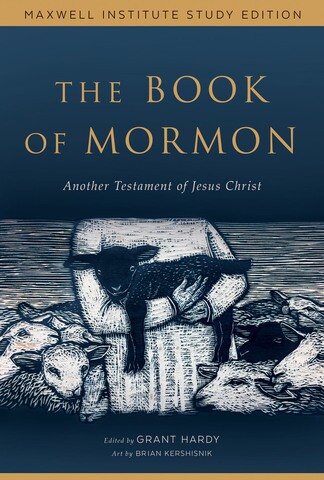Over thirty years ago President Benson challenged Church members to keep reading the Book of Mormon daily, along with their other scripture studies. Similarly, President Hinckley invited Latter-day Saints in August 2005 to read the Book of Mormon by the end of the year, and President Nelson extended the same invitation to the women of the Church in the last October Conference. If we add in our regular reading of the Book of Mormon in Sunday School, Seminary, Institute, and missionary scripture study, that’s a lot of times through 1 Nephi to Moroni.
While the witness of the Spirit and the blessings of obedience may carry many members forward in their reading, some may wonder if there is anything new to learn from a book that has been their constant companion for many years. For Latter-day Saints who are already very familiar with the Book of Mormon, help is on the way, inthe form of a new study edition from the Maxwell Institute and Deseret Book. Stephen Smoot recently sat down to talk with the editor, Grant Hardy, in anLDS Perspectives podcast about this new study aid, and what it might add to our understanding and appreciation for the sacred text at the heart of the restored gospel.
New Insights into a Familiar Text
This edition reformats the current official text into paragraphs with quotation marks, poetic stanzas, and section headings that highlight the narrative structure and clarify the sermons and stories. There are also footnotes identifying key literary features and interconnections. This is the first edition of the Book of Mormon that combines the official text with Royal Skousen’s groundbreaking research, offering several hundred instances of more accurate readings from the earliest manuscripts that were lost in the course of copying and printing. And at the end of the volume are the maps, charts, indexes, and supplemental information that one might expect in a study edition.
The attention to the details of wording and narrative means that even experienced readers are sure to gain deeper understandings and new insights in this volume, whether they are once again making their way through Nephi’s use of the brass plates, or Alma’s sermons, or the war chapters in Alma, or the Savior’s visit to the Nephites, or Moroni’s attempts to complete his father’s record.
For instance, did you know that Jacob begins and ends his book with quotations from Psalms 95, and his son Enos does the same thing? That the first two original chapters of Mosiah were lost as part of the 116 pages? That twenty-eight words in Alma 45:22 were written by Joseph Smith in the original manuscript, when Oliver Cowdery was temporarily incapacitated? That there were two Amalickiahite wars, with the second taking place on two fronts simultaneously? That the Lord himself identified the events of Helaman 5 as some of the most significant in Nephite history? That only two of the three days of Christ’s ministry in Bountiful were recorded in Mormon’s account? Or that the book of Ether includes six distinct editorial comment sections from Moroni?

Brian Kershisnik creates the cover art for a new study edition of the Book of Mormon. Screenshot from YouTube.
That’s the first Book of Mormon you will encounter in the Maxwell Institute Study Edition—one that will be appreciated by readers looking for deeper engagement with an already familiar and well-loved sacred tex
Easy-to-Study Format for New Readers
But there is a second Book of Mormon in there as well—for new readers who are coming to the text for the first time, perhaps as teenagers or new converts or members returning from a period of inactivity. It is entirely possible to enjoy the benefits of this study edition without paying much attention to the footnotes. Because it is reformatted into paragraphs with quotation marks, like most other books, it reads more easily and quickly than the standard verse-by-verse presentation.
The stories flow, the dialogue is easy to follow, and the basic structure of the book (small plates, large plates, etc.) is readily recognizable. In particular, the section headings generally identify who is speaking, on what topic, and in what circumstances. Indeed, just thumbing through the pages and skimming the headings will provide an accurate overview of the book’s major stories and messages. That makes it easy to put key verses and teachings into their proper context. And the poetic formatting will even help readers make sense of the many Isaiah chapters.
One of the most striking features of this new study edition are the full-page woodcuts at the beginning of each book. They were commissioned especially for this volume and were created by the celebrated LDS artist Brian Kershisnik. They offer a rather different take on Book of Mormon stories from the familiar paintings of Arnold Friberg or Minerva Teichert or Walter Rane, but they beautifully and sensitively illuminate the text in new ways.
A Book of Mormon that both highlights complexity and at the same time is easier to read; that is well-suited to both experienced and new readers; and that rewards different approaches and needs—that is what the new Maxwell Institute Study Edition offers, as it strives to make the book’s testimony of Christ as accessible, inviting, and compelling as possible.
Lead image from lds.org
A transcript of the interview with Hardy is available at LDS Perspectives Podcast. If you would like to check out the Maxwell Institute Study Edition yourself, it can be ordered here.
Grant Hardy is a professor of history and religious studies at the University of North Carolina at Asheville. He has a BA in Ancient Greek from Brigham Young University and a PhD in Chinese language and literature from Yale. He is the editor of The Book of Mormon: A Reader's Edition and the author of Understanding the Book of Mormon: A Reader's Guide, available at Deseret Book stores and deseretbook.com.







